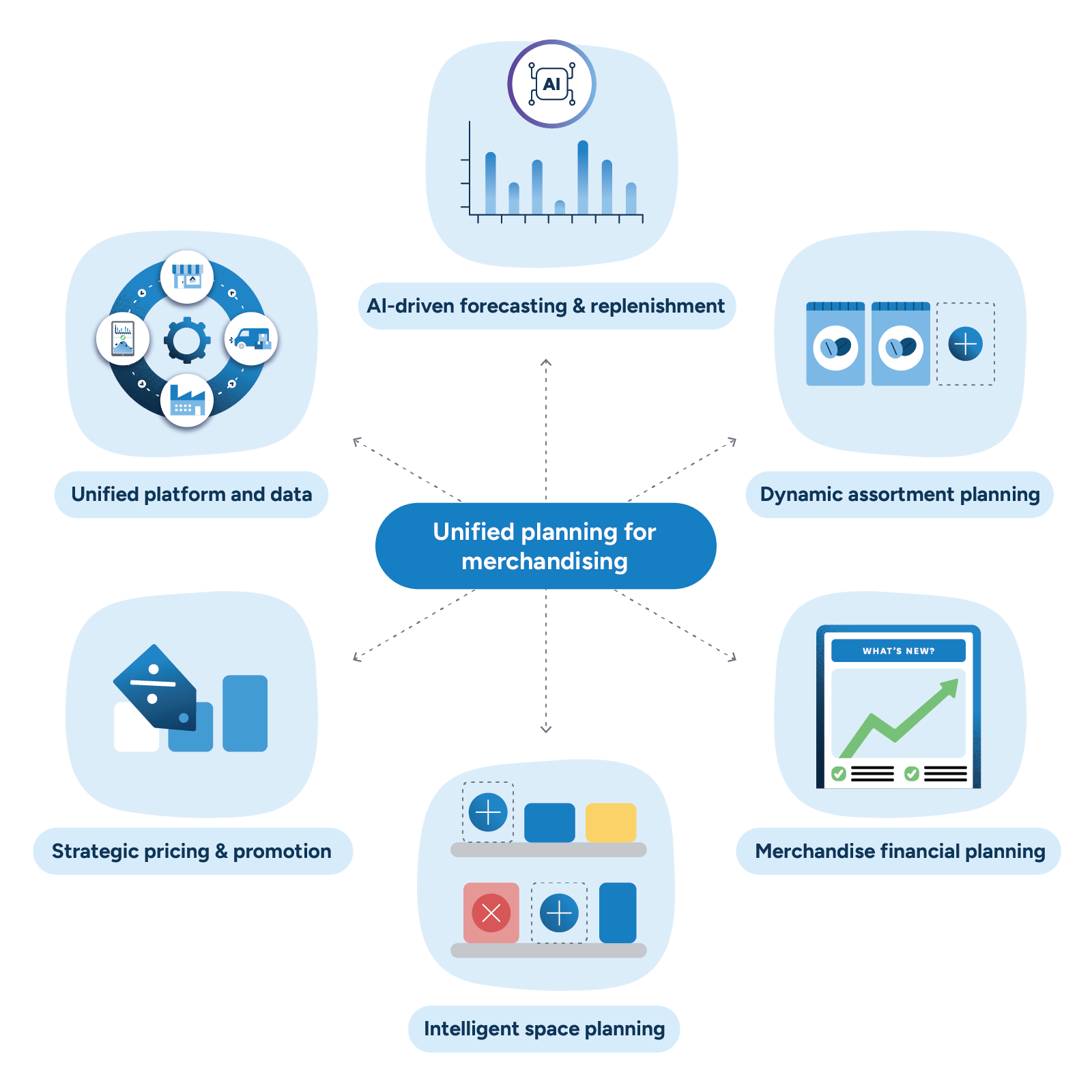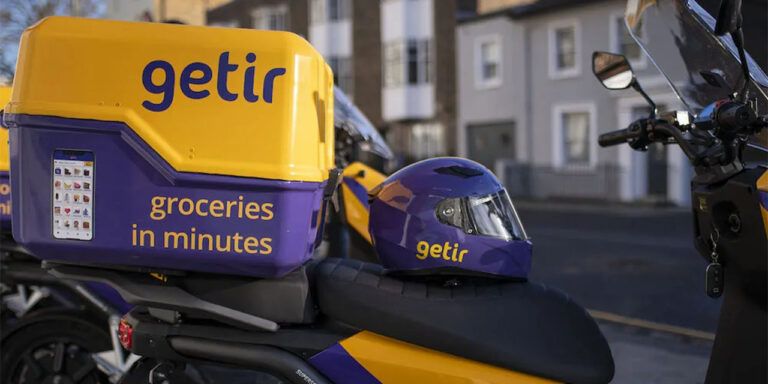Retail merchandising blind spots and why they matter
In retail, no decision stands alone. Every pricing change, promotion, assortment choice, planogram revision, and inventory allocation adjustment ripples across the business, right down to the customer.
Merchandising decisions are critically impactful, but plans that look good on paper often break down in execution. Financial goals don’t match store realities. Promotions overwhelm capacity. Supply chain constraints aren’t factored into merchandising choices. When those decisions are made in silos, the ripples collide, creating stockouts, overstocks, margin erosion, and customers abandoning their baskets to shop with competitors. These failures hit the bottom line, damage customer relationships, and make execution harder for functional teams.
“Retail planning – supply chain, merchandising, and store planning – is often done in silos. The line of business operates upon different data that rarely ties together,” says Brian Kilcoourse, Managing Partner at RSR Research. “This creates all kinds of organizational friction, usually measured by lost sales, diminished profitability, too much inventory in the wrong places, and not enough in the right places. Retailers don’t have to put up with this any longer. Modern systems are capable of working much better than most retailers realize.”
Consulting firm McKinsey & Company finds that siloed retail operations typically unlock just 5% to 10% efficiency gains, while fully unified, cross-functional models capture 10% to 15% cost savings and deliver a better customer experience.
“End-to-end (e2e) excellence is a paradigm-shifting mindset that also doubles as an operations playbook.” – McKinsey & Co.
What are the most common merchandising blind spots retailers face?
| Blind spot | Impact |
| Forecast accuracy gaps | Over-buying ties up capital in unneeded inventory and forces markdowns. Under-buying creates missed sales and empty shelves that drive customers away. McKinsey estimates markdowns alone represent approximately 12% of total sales, costing US retailers over $300 billion annually. |
| Margin erosion from poor promotions | Heavy reliance on promotions planned in isolation from supply chain and space allocation cuts into profitability. When promotions run independently, retailers pay to advertise products they can’t stock properly, resulting in frustrating customers while burning through marketing budget and margin. |
| Localization failures | Generic assortments waste valuable shelf space and frustrate local shoppers who expect retailers to understand their unique demand. One-size-fits-all merchandising is no longer enough in an era of heightened customer expectations. |
| Price perception conflicts | When online prices beat in-store prices, customers feel cheated. These perception gaps, whether between channels or competitors, push loyal shoppers to alternative retailers who they perceive to have more consistent pricing. |
| Trend blindness | By the time traditional planning catches shifting demand, competitors have already captured the opportunity. Speed to market now determines who wins, and siloed systems create delays that cost market share. |
| Data fragmentation | Fragmented data across merchandising, supply chain, and finance prevents teams from gaining actionable insights. The visibility gaps between functional teams lead to poor decisions that create mounting problems upstream and downstream. |
Customers don’t see these as operational challenges. They see broken promises that erode loyalty, damage credibility, and translate directly into lost sales, and not just for one item, but entire baskets. The basket abandonment trigger, what McKinsey calls the “walk rate,” occurs when demand doesn’t transfer to another product but disappears entirely, costing up to 4 percentage points of gross margin. When assortment gaps exist, walk rates can reach up to 20%.
Leading retailers are eliminating blind spots by unifying their planning, execution, and optimization into one connected platform.
The hidden cost of disconnected planning
Retailers invest heavily in the teams that drive their business. However, when disconnected planning creates visibility gaps between those teams, poor decisions and inefficient execution are inevitable. The impacts of merchandising decisions magnify as they travel throughout the retail value chain, and the associated costs of poor decisions due to siloed planning cascade into significant negative consequences.
Consider this common scenario:
- First, inadequate merchandising and assortment decisions strain supplier relationships and disrupt procurement, leading to unpredictable product availability and increased costs.
- Second, these disruptions cause inventory imbalances, with stores facing overstocks of some items and shortages of others, tying up capital and affecting sales.
- Third, the imbalances necessitate last-minute adjustments in logistics, increasing transportation costs and complicating distribution schedules, which delays product availability to stores.
- Fourth, delayed or inconsistent availability prevents effective promotions and reduces customer engagement, hurting sales and brand loyalty.
The financial impact extends beyond immediate operational costs:
Supplier relationships deteriorate: Misaligned forecasts and chaotic promotions make retailers unreliable partners, increasing costs and reducing negotiating flexibility.
Labor productivity plummets: Store teams waste hours managing the chaos of misaligned promotions, incorrect shipments, and constant firefighting instead of focusing on customer service.
Customer lifetime value erodes: Each broken promise chips away at loyalty. In today’s market, customers have too many options to tolerate repeated disappointments. The compound effect of these failures can reduce customer lifetime value by 20% to 30%.
“The objective of any modern retail planning function is to put inventory where it’s most likely to sell at its full markup without over-inventorying or putting customer satisfaction at risk. Anything less is sub-optimized today.”
Brian Kilcourse, Managing Partner, RSR Research
The pillars of merchandising excellence
Building unified merchandising requires interconnected capabilities that work together as a foundation for transformation.

Demand-aware replenishment
Factor price changes, promotions, and local events into every inventory decision. Replenishment that doesn’t account for merchandising decisions creates the feast-or-famine cycles that destroy customer trust. AI-powered forecasting that considers promotional calendars, pricing strategies, and space constraints ensures products are available when and where customers expect them.
Dynamic assortment planning
Localize ranges based on actual customer behavior, not assumptions. Store clustering and space-aware assortment planning work together to create store-specific ranges that maximize sales per square foot while reflecting local preferences. This moves beyond generic assortments to true localization at scale.
Merchandise financial planning
Connect budgets to actual execution. Stop planning in spreadsheets that are disconnected from operational reality. Integrated merchandise financial planning and open-to-buy systems ensure financial plans adapt to real-world supply chain constraints, space limitations, and execution capabilities. Finance teams gain budgets connected to reality, while merchants gain flexibility within guardrails.
Intelligent space planning
Ensure every planogram reflects actual demand patterns and replenishment capabilities. Space planning that operates in isolation from assortment and supply chain creates execution failures. Unified space planning connects planograms with forecasting and replenishment systems, cutting shelf breaches and increasing sales significantly.
Strategic pricing and promotion
Optimize for total profitability, not just top-line sales. Pricing and promotion planning integrated with supply chain capacity and space allocation prevents promotions that destroy margins or create operational chaos. Ensure profitable promotions have the inventory and space support needed to succeed.
Unified platform and data foundation
Break down silos with a single source of truth powered by AI that turns complexity into competitive advantage. A unified platform enables real-time collaboration and data sharing across merchandising, supply chain, and finance, which makes all other capabilities possible. This isn’t integration as an afterthought; it’s integration as the foundation that enables speed, agility, and continuous improvement.
6 strategies to turn disconnection into cascading advantages
Retailers can’t afford to let inventory risk, margin pressure, or blind spots dictate performance. Here’s how leading merchandising teams are tackling these challenges head-on using advanced planning technology:
1. Reduce inventory risk with AI-powered forecasting
Challenge: Over- or under-buying in key categories.
Solution: AI and machine-learning forecasting capabilities from RELEX analyze real-time demand signals, ensuring the right quantities are bought and allocated to stores, minimizing stockouts and overstocks.
Traditional planning methods are effective to a point, but often lack the speed and precision needed to stay ahead of competitors. Retailers can use AI-powered capabilities to provide real-time insights into emerging trends and consumer behavior. This capability enables category managers to quickly adapt assortments and space plans to ensure inventory aligns with shifting market demands, reducing the risk of unsold stock.
AI also helps retailers streamline the category and assortment review process, automating complex analyses and providing actionable recommendations. Automation reduces the time and effort required for manual evaluations, allowing teams to focus on strategic planning.
Selco Builders Warehouse, a UK leader in the supply of building materials, provides a wide assortment of over 12,000 SKUs, including building materials, flooring and tiling, decorator tools, and outdoor landscaping and fencing materials.
Selco needed a solution to automate processes and effectively leverage AI for data-driven planning. With RELEX, they have unified their planning across the business with in-store forecasting and replenishment, allocation, space planning, and planogram development.
“RELEX’s unified solution provides full visibility for accurate supply chain and space planning, giving us the flexibility we need to adapt to the differing levels of demand we see from our customers.”
Ian Kennedy, Operations Director, Selco Builders Warehouse
2. Improve trend prediction with real-time insights
Challenge: Reading the market wrong or adapting too slowly.
Solution: The RELEX solution’s advanced algorithms surface emerging trends early, allowing teams to pivot before competitors and avoid costly misreads.
AI-driven tools analyze sales performance, customer preferences, and seasonal variations to offer precise adjustments to assortments, increasing efficiency and accuracy to better inform decisions and optimize product mixes. AI-powered planning solutions even aid the buying process, predicting future product performance based on historical data and market trends.
3. Align financial planning with execution
Challenge: Merchandise financial plans (MFP) and open-to-buy (OTB) budgets don’t align with day-to-day realities.
Solution: RELEX connects top-down budgets with bottom-up execution, integrating MFP and OTB with space, assortment, and supply chain constraints. The result is dynamic plans that flex with real-world conditions.
Effective planning requires the most recent information, and the effective communication of merchandising changes and decisions to departments like supply chain and marketing is essential to success. Advanced planning technology streamlines communication and collaboration across functions, enabling smooth execution at the customer-facing level.
4. Localize assortments with store-specific planogramming
Challenge: One-size-fits-all assortments that miss local needs.
Solution: RELEX combines store clustering with space-aware assortment planning to automatically generate store-specific planograms. These reflect local demand and capacity, improving sales and reducing waste.
The complexity increases as retailers aim to allocate specific goods to the right locations. Factors such as store size, region, customer behavior, and proximity to distribution centers must be considered, demanding a sophisticated process known as store clustering.
Decisions on assortment or merchandising don’t always align. Category managers determining assortments for specific store sizes sometimes discover that selected items won’t fit on shelves or leave excessive white space. The right planning software can spare category managers from this dilemma, helping them anticipate these issues and establish a real-time feedback loop to address potential errors.
RELEX customers who optimize planograms in combination with assortment removal suggestions can reduce the recurring shelf refill needs by 15%. Category managers who use receipt data can also identify frequently co-purchased products, further informing planogramming decisions.
5. Overcome data blindness with unified visibility
Challenge: Too much data, not enough insight.
Solution: The RELEX unified platform consolidates data across merchandising, supply chain, and finance – giving leaders actionable intelligence instead of fragmented reports.
Merchandising planning also demands meticulous coordination between retail headquarters and individual store operations. This coordination is crucial for determining the appropriate product mix for each location and timing for product rollouts, ensuring that stores are commercially sustainable.
Integrating supply chain data into merchandising planning helps avoid unprofitable purchasing decisions. Despite the crucial relationship to SKU profitability, category, space, and assortment planning often omits critical supply chain data like costs and efficiency metrics. Category and assortment planning supported by supply chain data helps identify underperforming products, facilitating their removal to reduce inventory levels and increase turnover speed.
Vallarta Supermarkets, a regional U.S.-based grocer, faced the challenge of managing 30,000 SKUs across its 55 stores, considering localization needs and unique shopper preferences.
Using RELEX, Vallarta has data-driven insights to better understand the performance of individual categories and assign the right amount of space to each category and each product in each store. Enhancing store layouts and category/product flows of stores or departments, and optimally placing best-selling items, helps maximize sales, reduce waste, and ensure customer satisfaction.
“We are confident that RELEX will help us to achieve our goals by enhancing our assortment planning and space utilization.”
John Sellers, SVP of Merchandising, Vallarta Supermarkets
6. Strengthen supplier collaboration to improve price perception
Challenge: Customers question whether your pricing is competitive.
Solution: With RELEX, retailers can share accurate forecasts and identify clear priorities to boost supplier relationships. Transparency builds trust, aligns suppliers, and helps strengthen negotiation power.
With a clear understanding of their optimal assortment and precise demand forecasts, retailers can approach suppliers with concrete data to support their negotiation arguments. They can demonstrate their commitment to specific products and volumes, potentially leading to more favorable commercial terms like better pricing, extended payment terms, or exclusive deals.
Clear plans regarding product placement across assortments and stores help teams strategically prepare marketing initiatives in advance, ensuring smooth operations and resonant promotions throughout the year. This optimized campaign planning process can decrease marketing spend and save it for more effective use, particularly attractive during economic downturns when consumers are especially cost-conscious.
Assess your merchandising maturity
Most retailers operate somewhere between constantly reacting to problems and systematically preventing them. This assessment helps pinpoint your current state and identify the specific capabilities that will move you forward.
Where does your organization stand on the path to unified merchandising?
| Foundation | Level 1 – Initial | Level 2 – Developing | Level 3 – Defined | Level 4 – Managed | Level 5 – Optimized |
| Merchandise Financial Planning & Open to Buy | Budgeting is isolated from daily execution and spreadsheet-heavy. | Manual OTB, limited visibility and agility to market demands. | Consistent MFP/OTB process, partially linked to ops. | Integrated finance & operations planning with shared data. | Unified planning, real-time alignment of finance, supply, and assortment. |
| Space Planning | One-size-fits-all template-based planograms. | Limited customization by store cluster. | Store clustering with some local variation. Driven by average data. | Store-level planograms using historical performance and forecasted demand, digitally delivered. | Optimized, data-driven planogram with projected deliveries and one-touch replenishment, digitally delivered. |
| Assortment | National lists, little localization. | Category-level, manual adjustments. Spreadsheet-heavy. | Defined process, moderate use of demand data. | Localized assortments aligned to financial, supply chain, and merchandise plans. | AI-driven, hyper-local assortments using CDTs, constraint-based modeling, and dynamic ‘what-if’ scenarios. |
| Forecasting & Replenishment | Forecast and ordering based on historical & sales targets. | Spreadsheet forecasts and ordering, limited accuracy. | Time series forecasting and siloed ordering and planning, basic tools in place. | Integrated planning across the supply chain, ML forecasting, and automated replenishment. | Unified planning, integrated with price/promo/space. |
| Price & Promotion | Generic strategies use little to no data. | Limited strategies and rules, supported by tools that perform calculations. | Dedicated roles, strategies, and frameworks used. Some processes are automated. | Multiple strategies and goals rolled out. Specialized software updates, manages, and optimizes plans. | Planning is connected to supply chain data. Pricing based on product lifecycle. Continuously developed modelling. |
| Platform & Data | Data siloed, inconsistent reports. | Fragmented systems, basic dashboards. | Standardized reporting, partial cross-functional data. | Integrated data platforms, proactive diagnostics. | Unified data backbone, predictive diagnostics, single version of truth. |
How to use this maturity assessment:
- Self-assess: Identify which level best describes your organization for each foundation.
- Prioritize: Focus on areas stuck at Level 1–2, where blind spots and hidden costs are most severe.
- Roadmap: Use Level 4–5 descriptions as your vision state, and build initiatives to close the gaps.
- Repeat: Re-assess every 6–12 months (McKinsey recommends quarterly or annual checkpoints) to track progress.
Unified AI-powered merchandising for tomorrow’s shelves
Complex product assortments, volatile demand, and rising margin pressure make siloed processes unsustainable. True mastery comes from unified planning that connects assortment, pricing, promotions, supply chain, and financials in real time.
“The proliferation of new data available about consumers and the competitive marketplace requires advanced tools.” Says Brian Kilcourse. “AI-based solutions can go far beyond analyses of past sales, consumer buying patterns, and competitive analyses that retailers have relied on for so long to establish their merchandise plans. The good news is that new tools can combine new data and internal historical sales data to help retailers model alternative demand scenarios to reflect conditions in the marketplace while they are happening–thus maximizing sales and profitability.”
With an AI-powered platform like RELEX, retailers gain end-to-end visibility, smarter automation, and the ability to anticipate ripple effects before they hit customers. The outcome isn’t just fewer failures – it’s cascading advantages across the business: higher availability, stronger supplier alignment, more efficient operations, and greater profitability.
“AI-based solutions can go far beyond analyses of past sales, consumer buying patterns, and competitive analyses that retailers have relied on for so long to establish their merchandise plans.”
Brian Kilcourse, Managing Partner, RSR Research
This is how today’s merchandising leaders move from constantly reacting to disruption to building resilience and driving profitable growth into every decision.
Take action: Three steps to unified excellence
1. Identify your blind spots
Use our Merchandising Maturity Assessment to pinpoint your most significant opportunities and understand where you stand compared to leading retailers.
2. Quantify the opportunity
Calculate the cost of continued silos versus the ROI of unified planning. Consider not just operational savings, but the value of customer trust and competitive positioning.
3. Begin your transformation
Connect with RELEX to explore how unified merchandising can transform your business.




